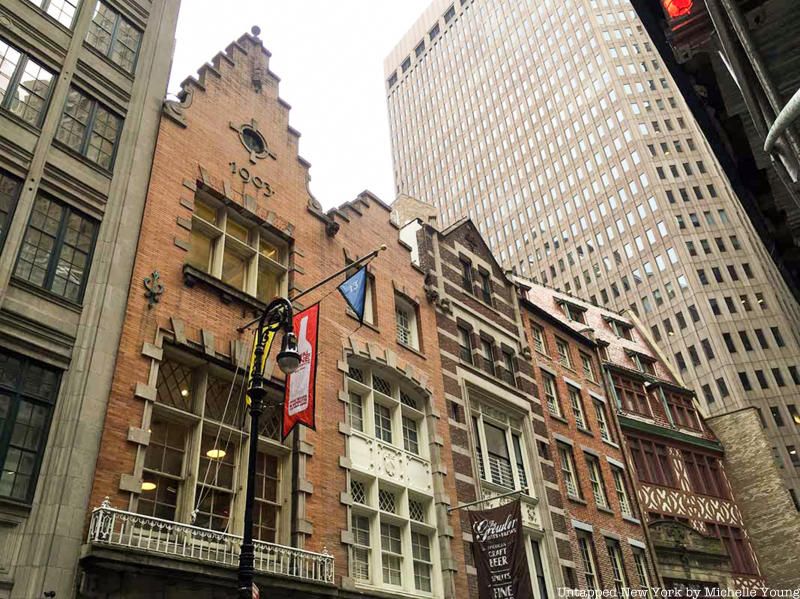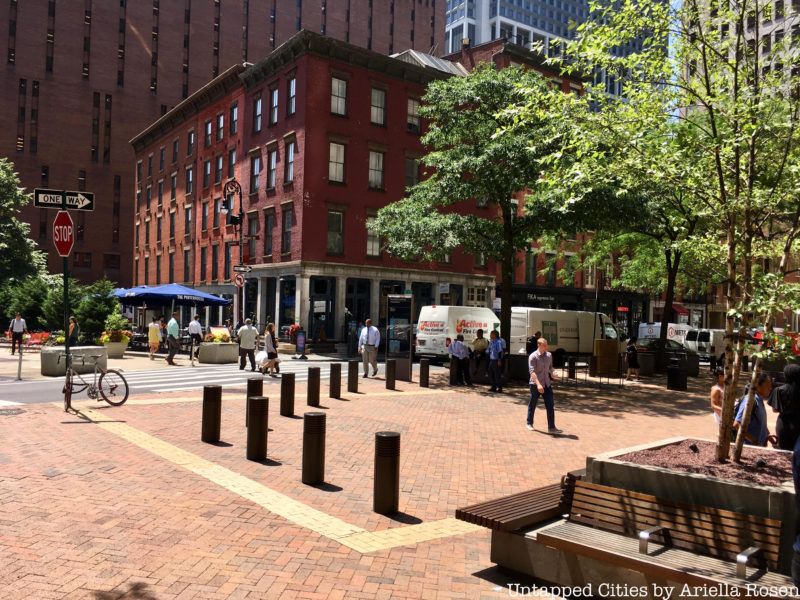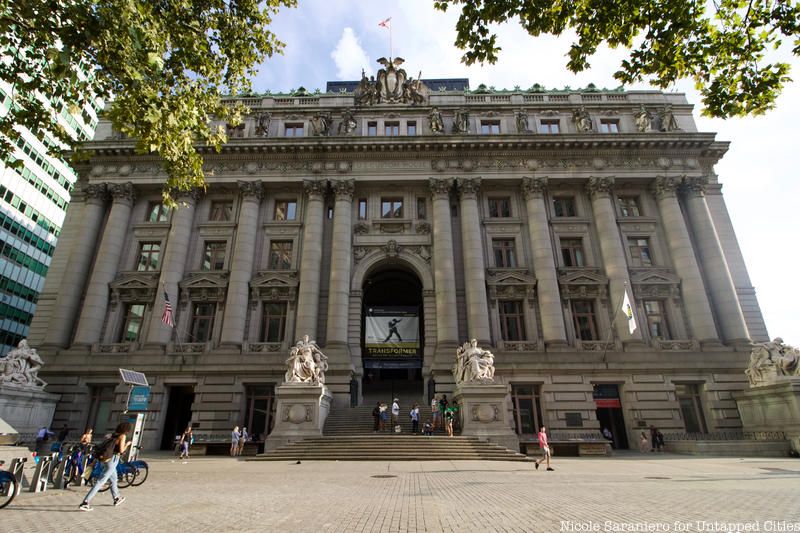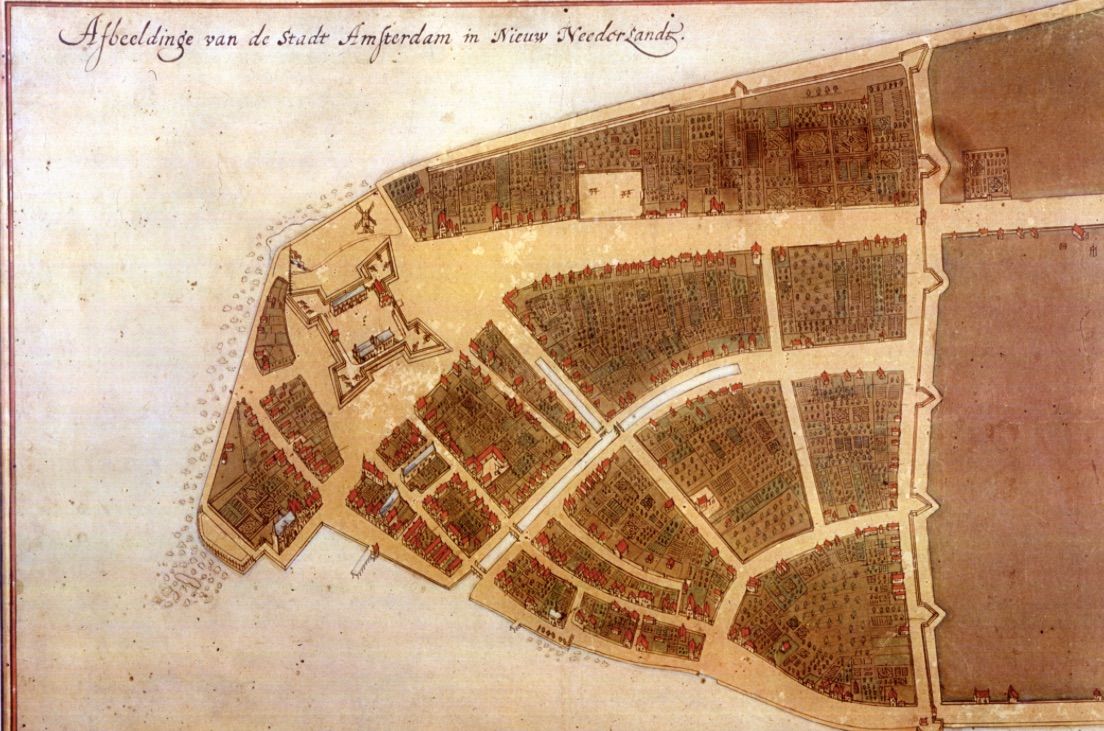Fiber Arts Take Over a Former Seaport Warehouse in NYC
See waterfalls of fabric, intricate threadwork, massive tapestries, and more!


This week in September was a big one for New York back in 1664, since on September 8, 1664 New Amsterdam became New York in name. In character, New York was forged earlier with the help of its original Dutch settlers. We at Untapped New York jokingly call our popular Remnants of Dutch New Amsterdam tour “DNA” not only short for Dutch New Amsterdam but also to recognize that the genetic material of this city stems from its short forty-year Dutch occupation. Yet, New Yorkers collectively remember so little of that pivotal conception since it’s often portrayed as a blip on our historical radar. There is a popular belief that for a few decades this city was known as New Amsterdam and suddenly one September morning in 1664, it became New York.
The deeper story of New York’s historic transition is rife with fake news and the outright lying of a vainglorious bigoted leader whose own constituents decided to use majority rule to quietly rebel against him. That leader’s name was Peter Stuyvesant, sixth Director General of New Netherland, staunch employee of the Dutch West India Company, and notorious hard ass. He also had a silver banded wooden peg leg to replace the one he lost during a naval battle giving him the nickname “Peg-Leg Pete” or Old Silver Bands.
In his eighteen-year term here’s what Stuyvesant did right: He built infrastructure, schools, city services, ensured economic stability, and brought moral order to an untamed New World outpost in danger of falling off the map. He unwittingly created a multi-cultural society with the perfect conditions for conducting peaceable business. In short, Stuyvesant tilled the soil to create the fertile ground from which New York sprang. Now here’s what he did wrong: He used the slave trade to create most of the things mentioned above and tried to promote his own non-tolerant and bigoted agenda at the same time. Luckily New Amsterdam had become so diverse that no one was listening.
 Dutch-style houses on William Street built in early 1900s
Dutch-style houses on William Street built in early 1900s
And yet Stuyvesant had made New Netherland so attractive that in March of 1664, James Stuart, Duke of York, and brother to the newly reinstalled English King Charles II asked if he could seize the land between the Delaware and Connecticut rivers from the Dutch so the English could have coastal supremacy in the New World. The King said yes only if he paid proper tribute and raised the funds to mount the expedition himself. He did and soon, Stuart sent out three well-armored frigates and about 1,200 soldiers across the Atlantic to claim New Netherland for King and Country.
Meanwhile what did Stuyvesant have to defend his charge? 150 ragtag soldiers and about zero warships. If provoked, the English could have leveled New Amsterdam in less than a day. Stuyvesant knew this, the English knew this, and most New Amsterdammers knew this. What was Stuyvesant’s strategy when he was told the English were coming? He lied about it, withheld information, and told everyone that he intended to fight to the death for New Netherland when the English arrived. And if people died doing so, eh they died doing so.
In charge of the The Duke’s forces was Colonel Richard Nicolls whose strategy was to transfer Dutch rule over to the English without firing a shot. After parking his fleet off of Gravesend (today Coney Island) in August of 1664, Nicolls sent a letter ahead of the invasion force promising that if New Amsterdam played it cool they would let everyone go about their business and life would be scarcely different. Stuyvesant intercepted this letter, and some say, burned it hoping that his citizens would never know about Nicoll’s fair deal. He wanted them outraged and ready to fight. Then, according to Gotham: A History of New York City to 1898, Stuyvesant received a second letter from neighboring English Governor and thorn-in-Pete’s-side John Winthrop Jr. backing Nicoll’s offer and pleading with Stuyvesant to avoid potential bloodshed. Stuyvesant ripped this letter to shreds again attempting to deceive his people a second time.

85 Broad Street today
Lucky for us all, the population of New Amsterdam was having none of it. Word got out that he was withholding the letters and according to Gotham‘s authors Edwin Burroughs and Mike Wallace “A crowd of irate workmen and magistrates gathered at the Stadhuis (its location now marked by a yellow brick outline outside of 85 Broad Street), where they made Stuyvesant reassemble Winthrop’s letter and read it aloud.” What’s worse, that afternoon Nicoll’s sailed his fleet from Coney Island through the Narrows and parked his forces right off present day Battery Park just to show Stuyvesant that his patience was wearing thin.

Location of Fort Amsterdam, now Alexander Hamilton Customs House
Stuyvesant, now furious, hobbled his way to Fort Amsterdam (today the footprint of the Alexander Hamilton Customs House) climbed to the bastion of the fort and told the lone gunman stationed there to ready the canons. But a respected clergymen by the name of Dominic Megapolenis “took him firmly by the arm and lead him down.” He convinced a religious Stuyvesant that God wanted cooler heads to prevail.
Not soon after, Stuyvesant was presented with a petition from 93 cooler heads, a collection of New Amsterdam’s most influential citizens including his seventeen-year-old son Balthasar. The document claimed that New Amsterdam was unanimous in their intention not to fight. They felt the English should just have New Amsterdam so everyone could go back to their business. Stuyvesant had, pardon the pun, not a leg to stand on. According to Russell Shorto in his groundbreaking work, The Island at the Center of the World, Stuyvesant mumbled that “‘I would much rather be carried out dead.'” Unfortunately for him, he was very much alive and forced to capitulate in person.

The original Castello Plan of Dutch New Amsterdam drafted in 1600 was found in the Villa de Castello in 1900 and was eventually donated to New York Public Library. Image via Wikipedia Commons.
On September 8, James Stuart’s plan bore fruit. The Dutch flag was lowered at 8 AM in the morning and the English inherited an abandoned fort. New Amsterdam became New York. Shorto goes on to infer what happened next with poetic flair, “Outside, the harbor winds were swirling around the interested throng of mixed nationalities who watched as the English flag went up the flagpole and listened as Nicolls declared the place renamed for his patron, the Duke of York and Albany.”
[post_featured_tour]
Allegedly, Nicolls offered any Dutch citizen who would not swear fealty to the King paid passage back to Amsterdam. No one took the offer, including Stuyvesant. When forced to answer to his superiors for outright his lying and incompetence, Stuyvesant said he was made a patsy for the Dutch West India Company. This is probably true since the company was not thrilled with the profits being turned in New Netherland and did not think it in their best interest to properly protect the colony. He also testified that the people of New Amsterdam were losers who refused to fight when duty called. He believed when all those nationalities were allowed to live together, peacefully in close proximity, they got soft. And thus the real DNA of New York was spun in a triple helix of drive, ingenuity, and tolerance.
Even Stuyvesant would choose to live out the rest of his days in the city he begrudgingly helped to create. On his bouwerie, the Dutch word for farm and the inspiration for the name of New York’s famed street Bowery, he lived out his life in peace with his family under his beloved pear trees. A lane leading to his farm still exists in the East Village today, jutting diagonally into the regimented grid today. And although the Dutch would strike back a few years later to reclaim the city, it was this important week back in 1664 when New Amsterdam became New York, and for a brief moment in time, the same place in name and in spirit.
Subscribe to our newsletter